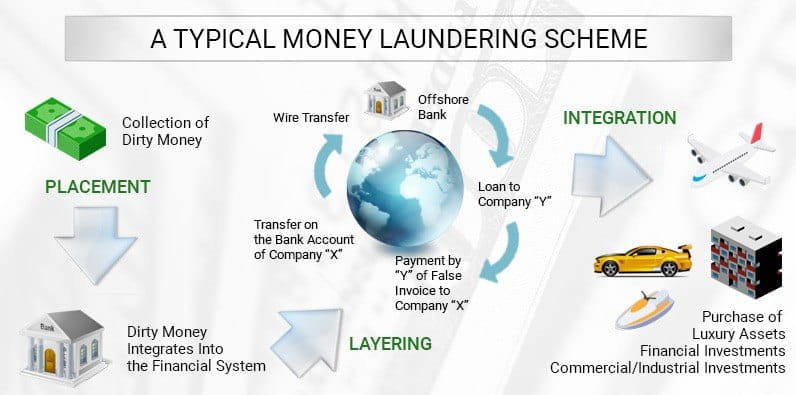Casino Money Laundering Stages
There you have it – three stages of a run of the mill money laundering. As a casino player, it is important that the payment card, bank account or means of deposit doesn’t link to any money laundering activity. It is also crucial to ensure that the online casino you choose to play isn’t participating in any kind of money laundering schemes. Perform real-time AML screening of your customers with Shufti Pro: Money Laundering, a process of disguising the original source a. Casino Implementing Rules and Regulations of Republic Act No. IMPLEMENTING RULES AND REGULATIONS OF REPUBLIC ACT NO. 10927, “AN ACT DESIGNATING CASINOS AS COVERED PERSONS UNDER REPUBLIC ACT NO. 9160, OTHERWISE KNOWN AS THE ANTI-MONEY LAUNDERING ACT OF 2001, AS AMENDED”. Money laundering typically occurs in three stages: placement, layering and integration. In Canada, money laundering is a criminal offence that covers all three stages of money laundering activity. The structure of gambling in Canada differs in important ways from many other jurisdictions, including the United States. Attorney-General David Eby gestures while showing a video of bundles of cash brought to a casino by a person, after releasing an independent review of anti-money laundering practices during a.
Money laundering has one purpose: to turn the proceeds of crime into cash or property that looks legitimate and can be used without suspicion. Here are some of the most common ways this is achieved.
There are usually two or three phases to the laundering:
- Placement
- Layering
- Integration / Extraction

Placement
- Cash businesses – adding the cash gained from crime to the legitimate takings. This works best in business with little or no variable costs, such as car parks, strip clubs, tanning studios, car washes, and casinos.
- False invoicing – putting through dummy invoices to match cash lodged, making it look like payment in settlement of the false invoice
- Smurfing – lodging small amounts of money below the AML reporting threshold to bank accounts or credit cards, then using these to pay expenses etc.
- Trusts and offshore companies – useful for hiding the identity of the real beneficial owners.
- Foreign bank accounts – physically taking small amounts of cash abroad, below the customs declaration threshold, lodging in foreign bank accounts, then sending back to the country of origin.
- Aborted transactions – funds are lodged with a lawyer or accountant to hold in their client account to settle a proposed transaction. After a short time, the transaction is aborted. Funds are repaid to the client from an unimpeachable source
Layering
Layering is essentially the use of placement and extraction over and over again, using varying amounts each time, to make tracing transactions as hard as possible.
Integration / Extraction
The final stage is getting the money out so it can be used without attracting attention from law enforcement or the tax authorities. In this regard, criminals are often content to pay payroll and other taxes to make the “washing” more legitimate and are often happy with a 50% “shrinkage” in the wash.
- Fake employees - a way of getting the money back out. Usually paid in cash and collected
- Loans - to directors or shareholders, which will never be repaid
- Dividends - paid to shareholders of companies controlled by criminals
Money laundering has one purpose: to turn the proceeds of crime into cash or property that looks legitimate and can be used without suspicion. Here are some of the most common ways this is achieved.
There are usually two or three phases to the laundering:
- Placement
- Layering
- Integration / Extraction

Placement
- Cash businesses – adding the cash gained from crime to the legitimate takings. This works best in business with little or no variable costs, such as car parks, strip clubs, tanning studios, car washes, and casinos.
- False invoicing – putting through dummy invoices to match cash lodged, making it look like payment in settlement of the false invoice
- Smurfing – lodging small amounts of money below the AML reporting threshold to bank accounts or credit cards, then using these to pay expenses etc.
- Trusts and offshore companies – useful for hiding the identity of the real beneficial owners.
- Foreign bank accounts – physically taking small amounts of cash abroad, below the customs declaration threshold, lodging in foreign bank accounts, then sending back to the country of origin.
- Aborted transactions – funds are lodged with a lawyer or accountant to hold in their client account to settle a proposed transaction. After a short time, the transaction is aborted. Funds are repaid to the client from an unimpeachable source
Casino Money Laundering Stages 2019
Layering
Layering is essentially the use of placement and extraction over and over again, using varying amounts each time, to make tracing transactions as hard as possible.
Integration / Extraction
Casinos Money Laundering
The final stage is getting the money out so it can be used without attracting attention from law enforcement or the tax authorities. In this regard, criminals are often content to pay payroll and other taxes to make the “washing” more legitimate and are often happy with a 50% “shrinkage” in the wash.
Money Laundering Through Casinos
- Fake employees - a way of getting the money back out. Usually paid in cash and collected
- Loans - to directors or shareholders, which will never be repaid
- Dividends - paid to shareholders of companies controlled by criminals